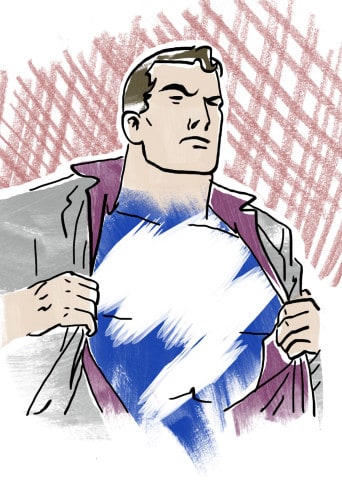 Comic books and graphic novels don’t have to be about rippling abs and superpowers to be great reads. There’s an entire world of twisting plot lines and enchanting characters that equally deserve the reader’s attention.
Comic books and graphic novels don’t have to be about rippling abs and superpowers to be great reads. There’s an entire world of twisting plot lines and enchanting characters that equally deserve the reader’s attention.
Don’t get me wrong — a good action- packed superhero story is enjoyable for any person. The plot arc of the long-absent or dead parental figure, the desire for vengeance and the inevitable donning of a slinky spandex costume and a badass new nickname is undeniably appealing. The reader knows exactly what they are getting into when they crack open a superhero comic and this brings with it a sense of comfort.
But there is a world of comic books and graphic novels that extends far beyond the mask-wearing vigilantes. These deal with unlikely heroes, often believable scenarios and real world issues — and this is perhaps the reason why they hit so close to home.
This article will look at three brilliant comics whose fascinating stories act as a gateway into the world of the non-superhero graphic novel.
Kicking off the list is author Brian K. Vaughan and illustrator Pia Guerra’s Y: The Last Man. A five-book dystopian series, Y explores a world in which the Y-chromosome has been eliminated from Earth, leading to the sudden death of every male, both human and animal — with two exceptions.
Yorick Brown and his pet capuchin monkey Ampersand are the last two males standing after the mysterious gendercide. In a desperate attempt to reach his fiancée Beth DeVille, who is stranded in the outback of Australia, Yorick embarks on a dangerous journey across the world. Alongside his reluctant companion and bodyguard Agent 355, Yorick battles the Amazons — a gang of bloodthirsty women who believe that the eradication of the male is the best thing to have happened — and gets sidetracked by alternate plotlines in his fumbling attempts to keep both himself and possibly the human race from extinction.
Y is a fascinating, beautifully illustrated look at a world without men. Vaughan’s use of character development is perhaps the most impressive aspect of the novel as it explores the personalities of strong female figures such as Agent 355, Dr. Alison Mann — expert in human cloning who may have the answer to the catalyst for the gendercide — and Jennifer Brown, Yorick’s mother who also happens to be a prominent member of the now wholly female American government. Characters such as these engross you in the storyline to the extent that you may find yourself cheering alongside your favourites when they succeed and mourning with them when they fail — a hallmark feature of a well-written plotline. A page-turning journey, Y compels readers to return to it again and again.
If dystopian worlds are up your alley, author and illustrator Matt Kindt’s three-book series Mind MGMT is certainly worth a read as well.
Taking place after a flight in which all the passengers simultaneously lose their memories, Mind MGMT follows the story of young ambitious writer Meru who is seeking answers to this large-scale bout of amnesia. In the process however, she stumbles upon a much bigger and darker secret — an undercover government program called Mind Management.
In a world where talking dolphins, subliminal messaging, psychics and unkillable assassins are the norm, Meru struggles to put the pieces together to solve the mystery of the amnesia flight and discover the location of Henry Lyme, the one person who managed to escape the plane unscathed.
Mind MGMT is an unsettling and fast-paced thriller that unfolds in a series of gorgeously illustrated frames that almost look as though they were created with watercolour paint. Dealing with some truly disturbing instances of mind control and government conspiracy, the novel leaves the reader baffled and suspicious of everything around them — but in the best possible way. A comic that can make someone question their own reality is truly a work of art and Kindt’s masterful storytelling in Mind MGMT is certain to make anyone check their phones and teddybears for bugs.
Last but not least is the deeply disturbing, skin-crawling world of Charles Burns’ Black Hole.
A word of caution for anyone delving into this graphic novel: The phrase “viewer discretion is advised” has never been more applicable. Unfolding the lives of a group of detached teenagers in the 1970s, Black Hole deals with what would seem to be stereotypical vices — sex, drugs and alcohol — by taking them to a whole other level.
Naturally after indulging in gratuitous sex and drugs, you would expect at least one of the characters to get a nasty sexually transmitted infection — but no one could have predicted this result.
The small Seattle suburb quickly becomes riddled with mutated, tail-sprouting teens carrying a rare and particularly gruesome form of STI. It is this disease that gives the comic that horror-movie feel. With full-page illustrations of festering wounds and deformed genitalia, Black Hole certainly isn’t for the faint of heart — but the exploration of the feelings of alienation and emotional instability that often accompany adolescence are what make the novel resonate so strongly within the reader’s mind. Much like seeing a train wreck happen, a sort of horrified fascination accompanies the reading of Black Hole — as much as you want to, you just can’t seem to pull your gaze away. It is this feeling that makes Burns’ work linger in the mind long after it has been put down.
While there will always be a special place in the heart of fans for iconic superheroes, diving into the world of the alternative comic is a rewarding and insightful journey in which the most average and unassuming of characters are given their chance to shine.
—
Graphic: Stephanie Mah/Graphics Editor